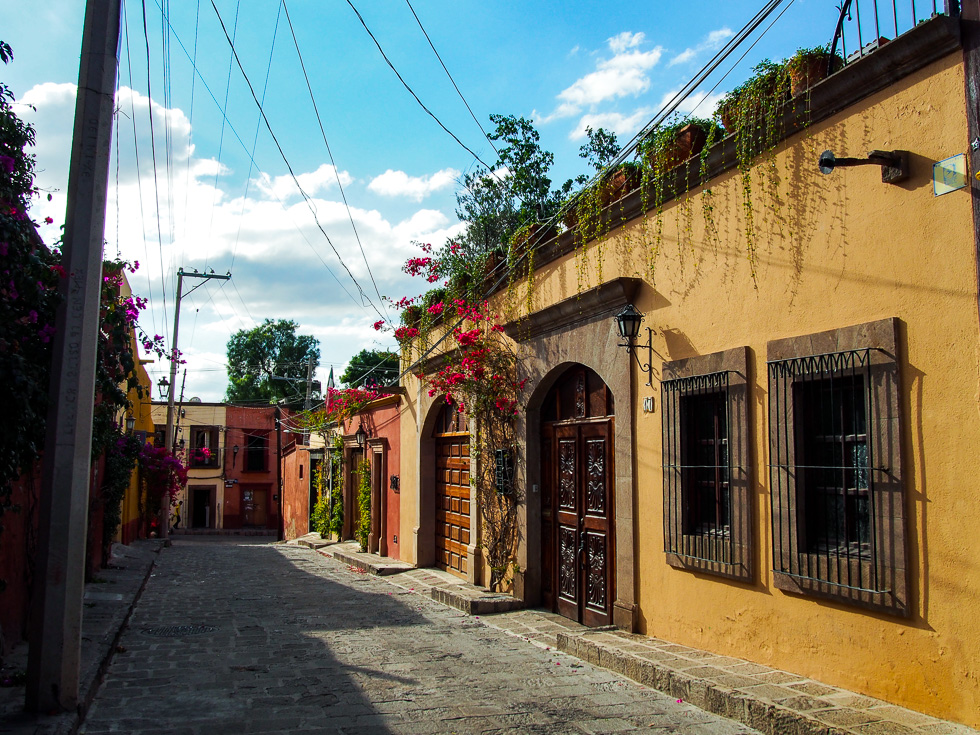
Peaceful streets in San Miguel de Allende, Mexico
Trigger warning for discussion of sexual assault and violence against women.
As part of my three month tour through Mexico, I knew that I wanted to make a stop in picturesque San Miguel de Allende. After a very eventful week in Mexico City, I hopped on a bus, ready to arrive at stop number two of my Mexico trip. As expected, San Miguel was absolutely beautiful, with cobbled streets, rows of colorful homes, and clusters of bougainvillea pouring over the tops of buildings and twisting along walls. Just walking around in this tranquil town was a gift. I spent three nights in a hostel in a quiet and residential part of the city, a brief walk away from the center square. It was in my hostel that I met Jorge*, the hostel owner.
Jorge was a friendly and accommodating man who never hesitated to give me tips and recommendations for things to do around San Miguel. He also loved to dance salsa, and we danced a few salsas together right there in the hostel. On my first night in San Miguel, I bumped into Jorge in the hostel kitchen. He invited me to drink a beer and we sat down together, sipping from the cold cans and getting to know one another.
We ended up talking for a few hours, during which time I told him about myself, my reasons for being in Mexico, and some of my dreams and goals for the future. Jorge told me about his life in San Miguel, about working in tourism, and about some of his own travels around Mexico. And beyond the regular getting-to-know-you subjects of work and hobbies, we also talked about feminism.
Feminism (everyone’s favorite F word!) came up because Jorge asked me what this blog is about (travel, social justice, dance, and more, by the way). This piqued Jorge’s interest, opening up a long conversation about feminism, social issues, and writing. Then Jorge asked if he could talk to me about an idea for a story he was thinking of writing that touched on these themes.
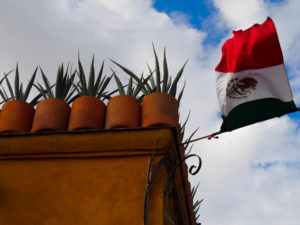
Looking up in San Miguel: rooftop plants and a billowing Mexican flag
Jorge’s idea was a story about a teenage girl who is from a big city in Mexico. We’ll call her the protagonist. The story begins when she travels to the Yucatan for vacation. Upon arrival in the Yucatan, the protagonist goes to a party, meets a smooth-talking bad guy, and goes with him to his house where he subsequently rapes her. This atrocity is somehow accidentally recorded on the girl’s phone. When she goes home, she is distraught but says nothing about what happened to her parents. But eventually, the girl’s concerned father finds this recording, and uses it to track down his daughter’s rapist. The father goes to the Yucatan and castrates the rapist. The plot in a nutshell.
As I listened to Jorge’s narration of this gruesome and tragic tale, I couldn’t help but feel a really strong mix of emotions. I felt a sense of mourning for this fictional girl, a product of Jorge’s mind, yes, but also whose story is way too common. We have all known some version of this protagonist, or have been some version of this protagonist. (And if you don’t think you don’t know a victim of sexual assault in your own life, I assure you that you do and they just haven’t told you.) Sexual assault is disturbingly common: in the United States, 1 out of every 6 women experience sexual assault in their lifetime. In Mexico, it was estimated that between 2010 and 2015, approximately 600,000 cases of sexual abuse occurred per year, and in 80% of these cases, women were the victims. Globally, 1 out of every 3 women will experience sexual assault.
Listening to Jorge, I also felt a sense of distress about the prospect of this untold story, and what it would mean if he were to actualize it into a book or a screenplay or any sort of consumable pop culture. Women’s bodies are continually raped, mutilated, and killed as part of “entertainment” in movies, TV shows, music, books, video games, and more. Simultaneously, “real life” sexual assault, intimate partner violence (also known as domestic violence), and femicide are incredibly commonplace. The gratuitous use of violence against women in pop culture not only mirrors our systemically violent culture, but also reinforces this systemic violence in a big, ugly cyclical way. It is only through the careful telling (or dismantling) of plot lines such as Jorge’s can we hope to counter this culture of violence and partake in a culture that is intolerant of sexual assault.
Does that sound like a lot? Let’s break this thing down.
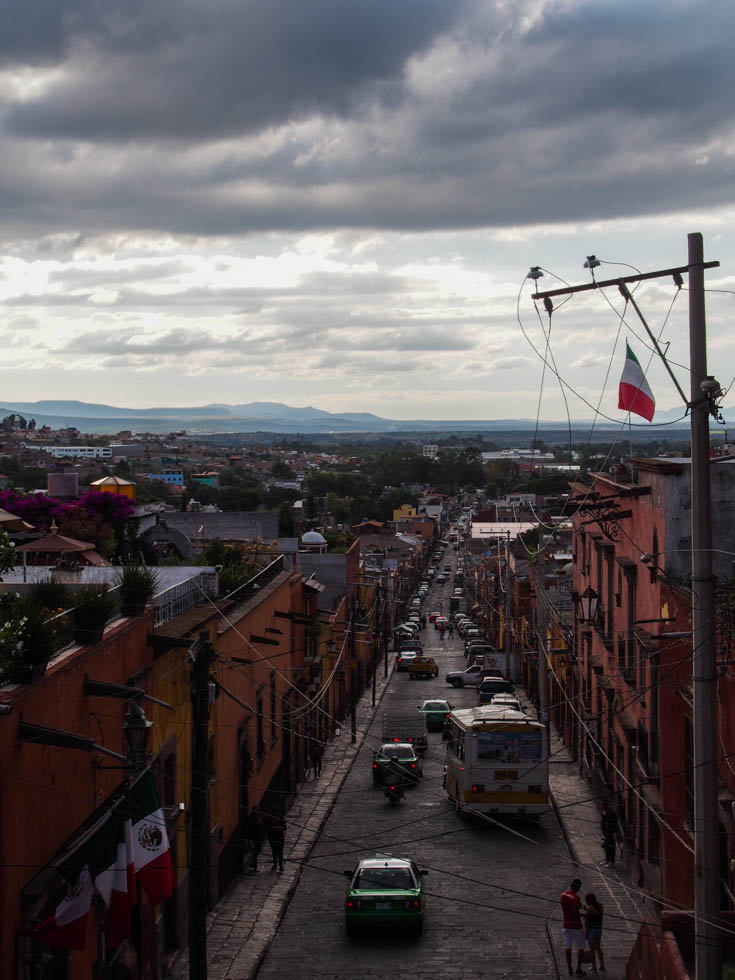
Sam Miguel streets on a cloudy day
Let’s talk about rape culture for a minute
In order to understand the implications of violent pop culture in our society, particularly how violence in pop culture affects women and/or victims of sexual assault, we must first understand rape culture. It’s a scary, unnerving, crappy term, I’ll give you that. What exactly is rape culture, and what does it have to do with this conversation?
The article Rape Culture 101 starts off with this definition:
A rape culture is a complex of beliefs that encourages male sexual aggression and supports violence against women. It is a society where violence is seen as sexy and sexuality as violent. In a rape culture, women perceive a continuum of threatened violence that ranges from sexual remarks to sexual touching to rape itself. A rape culture condones physical and emotional terrorism against women as the norm.
In a rape culture both men and women assume that sexual violence is a fact of life, inevitable as death or taxes. This violence, however, is neither biologically nor divinely ordained. Much of what we accept as inevitable is in fact the expression of values and attitudes that can change.
Rape culture, essentially, means a society that normalizes, tolerates, and even encourages sexual violence. It is a consequence of rape culture that sexual assault statistics are so high. Some other great articles with background information on rape culture include: Rape Culture: What It Is And How It Works and What Is Rape Culture?
Perhaps the most confusing and hard-to-grapple idea behind rape culture is that most of us – men, women, gender non-conforming folks, etc. – are all collectively horrified by the concept of rape. The cultural consensus is that rape is an awful and heinous crime, and that our society has laws in place that do things like throw rapists in jail. We think of rape as something that happens to some unfortunate women, generally by evil people who jump out of bushes. However, these conceptions of rape, while representative of some cases, do not speak to the magnitude of sexual violence in our culture.
Most sexual assaults (7 out of 10, according to RAINN) are committed by acquaintances of the victims – such as friends, intimate partners, coworkers, etc. When coupled with the high probability that women will experience sexual assault in their lifetime, our response should not be, “This must be a hoax!” Instead, our question should be, “How have the narratives that we’ve been taught about sex, love, and intimacy become so intertwined with violence that, as a society, we fail to recognize abuse, coercion, and sexual assault, even when it is happening right in front of us?”
Perhaps the scariest part about the idea of rape culture is that we’re all a part of it: both as victims and as contributors. And pop culture, including how we produce it, consume it, and learn from it, plays a critical piece in either upholding, or dismantling, rape culture.
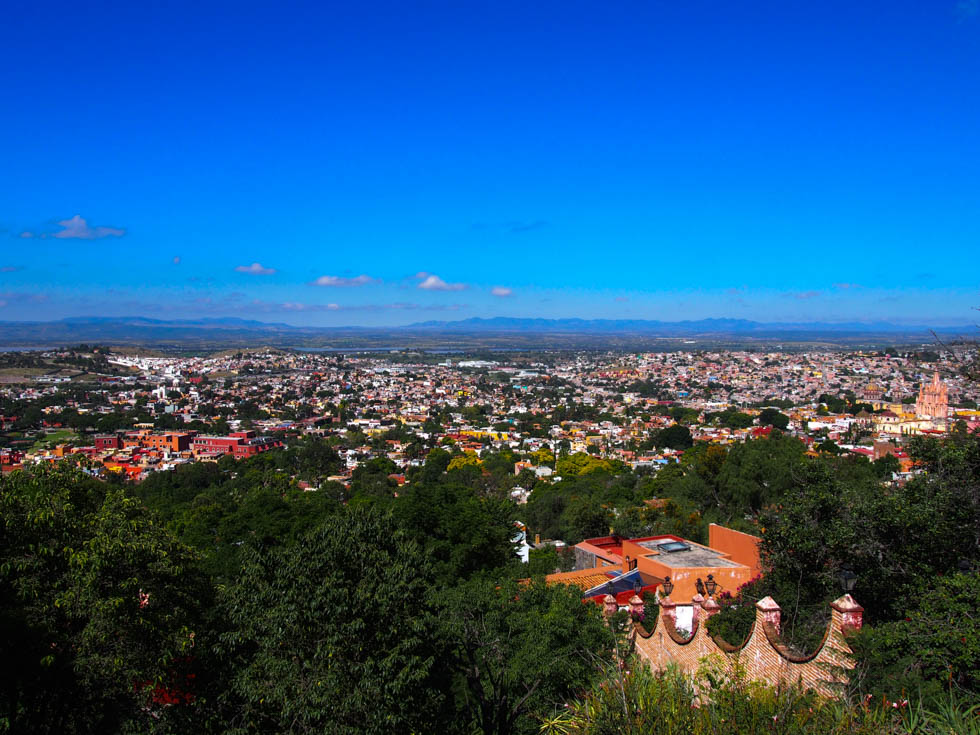
View of San Miguel as seen from a mirador in the city
But how does pop culture actually contribute?
Pop culture is relevant because it is so influential in our society. And how could it not be, when it is so far-reaching that it encompasses everything from movies to TV shows to fashion to music to books to advertising to video games to sports to news to technology and even to politics? Pop culture is essentially the representation of how mainstream society thinks and acts.
Pop culture is also an education source, because it serves as a model for the way things are or the way we should behave. It is particularly influential in the education of children. According to Jennifer Rowsell citing a study by Karen Wohlwend, “children perform their identities through media and, in turn, media and popular culture powerfully shape children’s thinking and learning.” But it’s not only children who are affected by pop culture – the images and scenes that we see play out through pop culture can cause anyone, adults included, to examine our perspective and the things that we believe to be true. Conversely, pop culture can serve as a reinforcement of the status quo, especially when dictated by society’s most privileged voices who benefit (either knowingly or unknowingly) from an unjust system.
Pop culture is also tremendously violent. Studies show that violence in movies has quadrupled since the 1950’s, and that there is more violence in today’s PG-13 films than there was in films rated R that were released in the 1980’s. TV has followed a similar trend. Violence sells, and much of what sells in TV shows, movies, music, books, and more is specifically violence against women.
Thus, media is violent and pop culture serves as an educational resource, but what are the implications of this? It means that we’re left with a society that learns through pop culture that violence against women is not only widespread, but that it’s a normal facet of our society. This is what normalization of violence looks like. Thus, violent pop culture both reinforces and contributes to rape culture, which has real implications for women around the world.

Cluster of bougainvillea in San Miguel
Writers’ workshop: dismantling rape culture in our contributions to pop culture
What does this mean for Jorge?
Jorge’s story, even in its brief summation, represents the gratuitous use of violence against women. And I say gratuitous, because the summary that he gave me represents a storyline that showcases female pain without female liberation. While the rape is central to the plotline, the end result is the father’s “liberation”. The protagonist who was raped, however, is cast aside. Jorge’s story is not about women, but about men; specifically, it’s about a man whose honor is restored because he castrates his daughter’s rapist. However, we viewers or readers have no idea whether or not this is what the protagonist would have wanted. Would this ending liberate her? Based on Jorge’s explanation, her role in the story seems to taper off as the perspective shifts to the father, once we have witnessed the horror of the violence that she faces.
What if, instead of shifting the focus to the father, we were to keep the focus on the protagonist the entire time? What if she were the one to ultimately castrate her rapist? What if there were no castration, but we follow her in her journey towards healing after the violence that she faced? What if she weren’t raped in the first place, but we got to follow her story of overcoming different hardships, such as navigating the challenges of school or work or love or family, because those hardships are also worthy stories to tell?
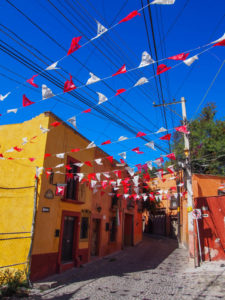
Flapping flags across a quiet street in San Miguel
There are so many ways to tackle this plotline that center and uplift the protagonist as the master of her own story. This is particularly important in our society that blames and belittles survivors of sexual assault. The false idea that victims of sexual assault are somehow to blame for the crimes committed against them is a pervasive narrative that perpetuates rape culture: it takes the onus off of rapists to not rape, and it puts the onus on victims to not get raped. It’s a twisted and illogical narrative, but one that we can smash by changing the way that we collectively think about rape. This includes comprehensive sex education that is inclusive of all sexualities (not just heterosexuality) and that centers consent. It includes teaching men to not rape. And it includes throwing myths about false rape accusations out the window, and always believing, listening to, and uplifting survivors of sexual assault.
They say to “write what you know”, and in this case, I think that is good advice. Jorge does not have firsthand experience with being a female, teenage rape victim, nor does he have experience with the everyday sexism and harassment that one experiences as a woman or a female-presenting person in the world. However, if he chooses to write this story, he can read and listen heavily to the experiences of sexual assault survivors. Their real stories of pain, trauma, and healing can help guide what one’s healing process might look like after a sexual assault, understanding that there is no one way to heal. Their stories of emotional fortitude can remind the consumers of this story that sexual assault survivors can and do thrive after their assaults, and that liberation exists for them too.
This is a critical step in dismantling rape culture. And as we tackle these storylines in pop culture, our cultural consensus regarding sexual assault can change. As writers, content creators, and creatives, the narratives that we write and reproduce have an impact, though whether or not this impact is positive or negative is up to us. They say the pen is mightier than the sword, and this is a prime example of that. I hope that through the stories that we write, we can dismantle this violent culture, causing sexual assault statistics to decrease, and together build a world that is safer for women everywhere.
*Not his real name
How do you feel about the amount of violence in pop culture? Do you believe that it perpetuates rape culture? What are some ways that you would recommend that we dismantle these violent systems in our society? Let me know in the comments below!
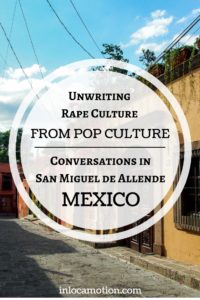









4 comments
This is beautiful and insightful, thank you for sharing. I do agree that rape culture and violence are ingrained in our media. My first reaction to Jorge’s story and dismantling the violence in media was he should write about something less violent and more uplifting. But, I LOVE that you give examples of how we can turn the story around to empower the protagonist- she can heal in so many other ways, and we can make the redemption about her. I hadn’t thought of that at all, probably because we rarely see it happening. I think rape stories that end that way are much better than not discussing it at all- since rape is so common in our society, but rape stories that don’t end with a male making things “right” again are not.
Hi Angelica! Thank you so so much for your comment, it really means a lot. I agree that there are so many ways to tackle this narrative, and it’s really important to disrupt the common male savior narrative. Thanks for your insight and support 🙂
I wish I could fit in everything I’d like to talk about pertaining to this subject! But I wholeheartedly agree, a revamp of sex education is needed to eliminate the machismo ideology of “hunter”. The norm seems to be a sense of entitlement over what/who can be overpowered.
As a young man, the majority of the talk amongst my peers was on how many “bodies” one can catch. This was a reference to how many sexual partners one can accumulate. This statement also ties into violence as well. “Catching a body” is lingo for murder. So why tie intimacy with murder? It is almost as if dominance is seen as the ultimate prize and not companionship. Toxic.
The tricky part is having these real conversations with adolescents and even children! Too many times I’ve witnessed inappropriate sexual comments and behaviors in my colleagues classrooms. I do everything I possibly can to nip these situations before they start. I would even meet with my male students to have a one on one discussions and share some perspective in hopes of opening up their minds. At times, I may feel defeated because of the overwhelming amount of media that shape these young men’s thought process and perception. Nonetheless the good fight must go on 🙌✊ phenomenal post 🙏👌
Hi Leonardo! Thank you so much for your thoughtful and thought-provoking comment! I also appreciate the insight on the idea of “catching a body” – I hadn’t heard of this before, though your observation is spot-on – and it just goes to show how closely intertwined and far-reaching violence is with sex and dating culture.
Otherwise, I think it’s wonderful that you are working actively with your students, especially young boys, to teach healthier mentalities towards sex and dating. That’s a fantastic use of privilege and a great show of allyship – thank you for doing that work. Yes, it is a long fight but the most important thing is educating young people, who actually have the potential to make a change.
Thank you for reading and commenting 🙂